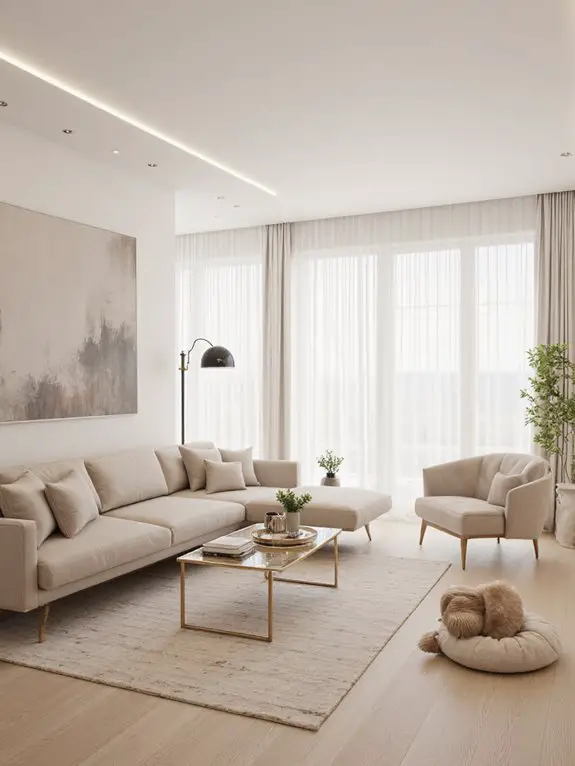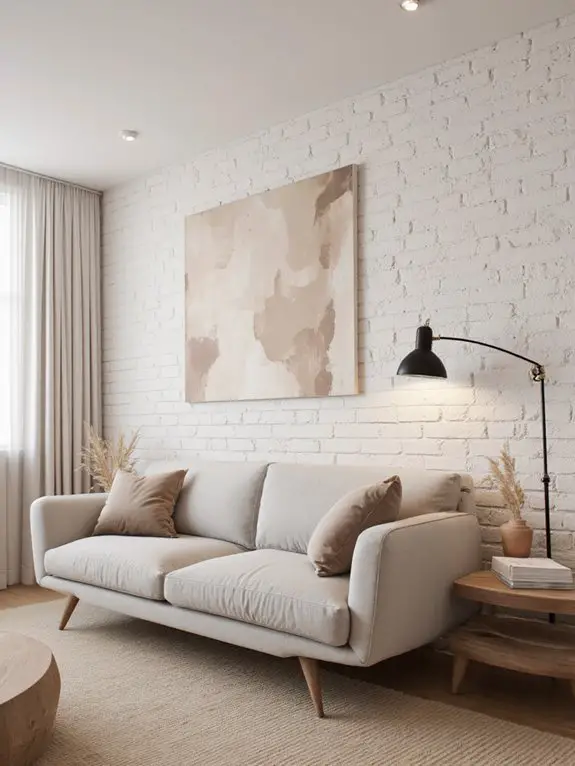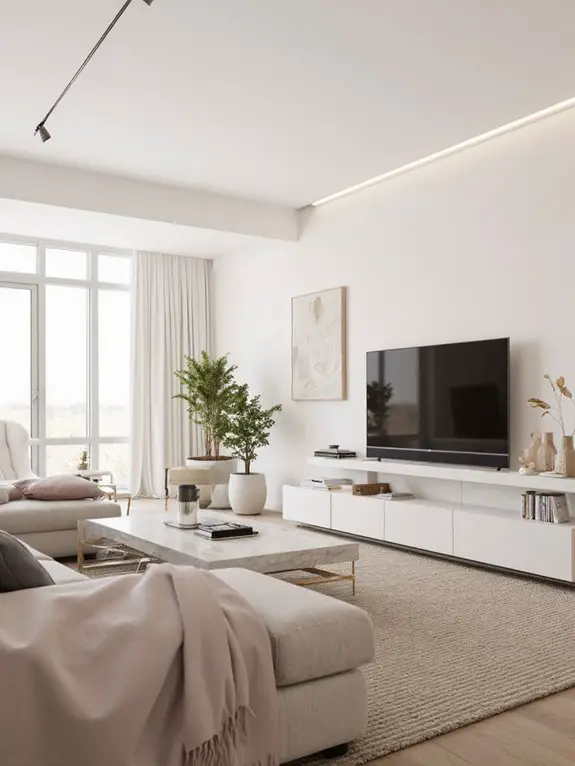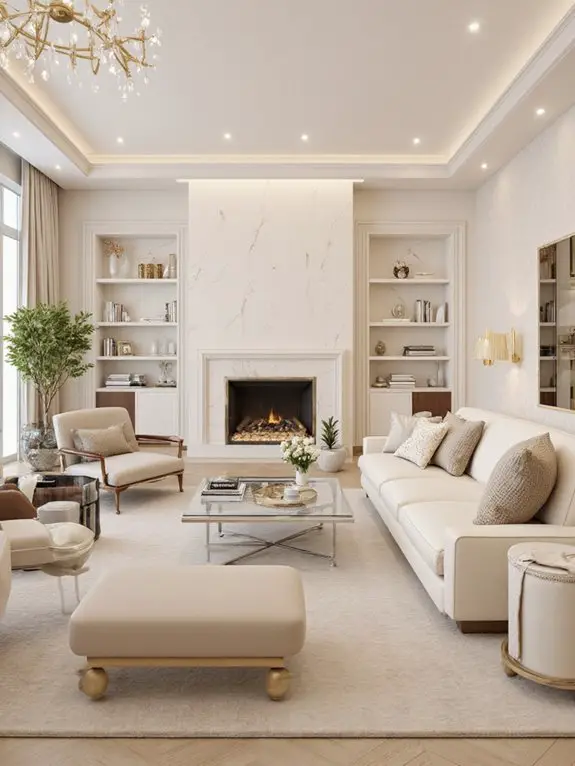I’ve found that transforming a living room starts with intentional design choices that balance style and functionality. Embrace minimalist principles by decluttering and choosing clean-lined furniture with neutral tones, while adding depth through layered textures like plush rugs and velvet cushions. Bold accent walls or striking lighting fixtures can serve as focal points, and open shelving offers both storage and decor opportunities. For a cozy touch, arrange seating around a fireplace with soft lighting. Discover more ways to elevate your space effortlessly.
Embrace Minimalist Design
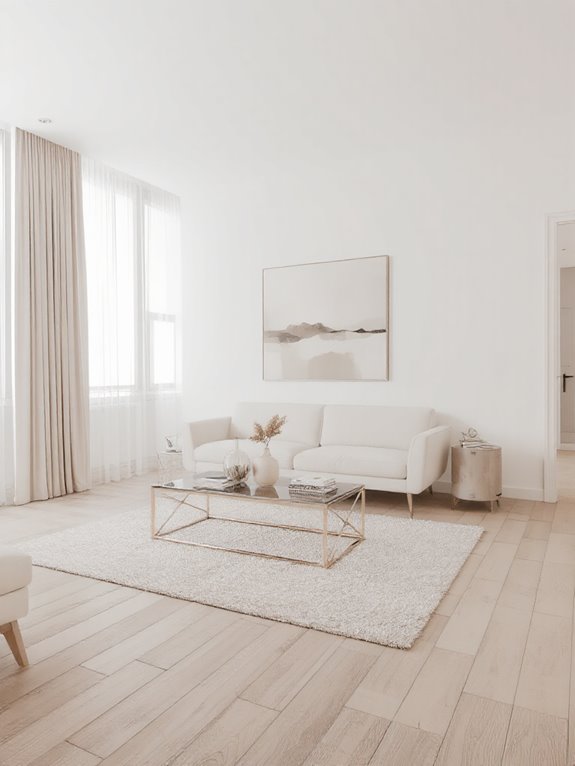
When I first considered minimalist design for my living room, I realized it’s not just about having fewer items—it’s about creating intentional space that feels calm and functional. I started by decluttering, keeping only what I truly need or love.
I chose furniture with clean lines and neutral tones to promote a sense of openness. Lighting became essential; I opted for soft, natural light and simple fixtures.
Storage solutions were key—I used multipurpose pieces like ottomans with hidden compartments. By focusing on quality over quantity, I transformed my living room into a serene, inviting space that reflects my lifestyle.
Incorporate Bold Accent Walls

Adding a bold accent wall can instantly transform my living room, making it a focal point that reflects my personality. I choose a wall that naturally draws attention, like the one behind my sofa or fireplace, and pick a striking color or pattern to make it pop.
I opt for deep blues, emerald greens, or even geometric wallpaper to create depth and interest. I guarantee the rest of the room complements the accent wall without competing, keeping furniture and decor simple.
This approach adds energy and character to my space, making it feel intentional and uniquely mine.
Choose a Neutral Color Palette
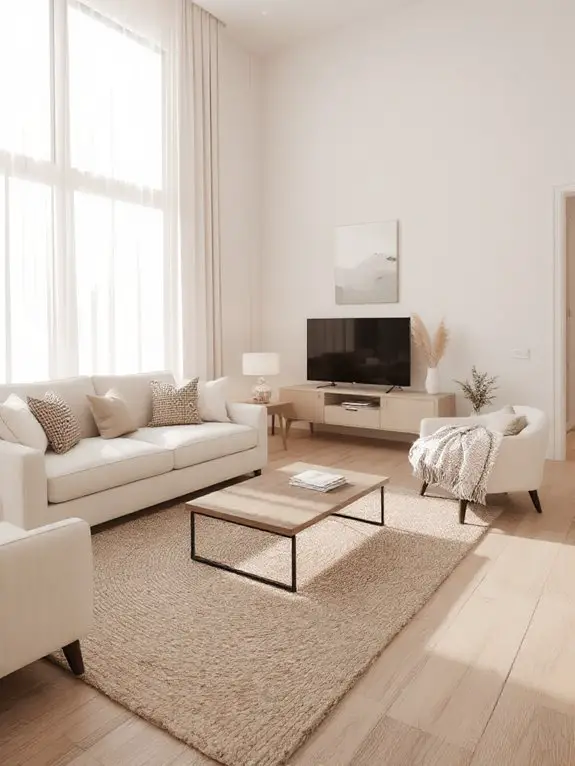
While bold accent walls make a striking statement, I often find that a neutral color palette brings a timeless and calming energy to my living room. Shades like beige, gray, or soft whites create a versatile foundation, allowing me to adapt decor over time without major changes.
I prefer pairing neutral walls with subtle undertones—warm grays for coziness or cool whites for freshness—to add depth without overwhelming the space. This approach also makes the room feel larger and more open, enhancing natural light.
A neutral base encourages creativity, letting furniture and accessories take center stage in a cohesive, serene setting.
Layer Textures for Depth
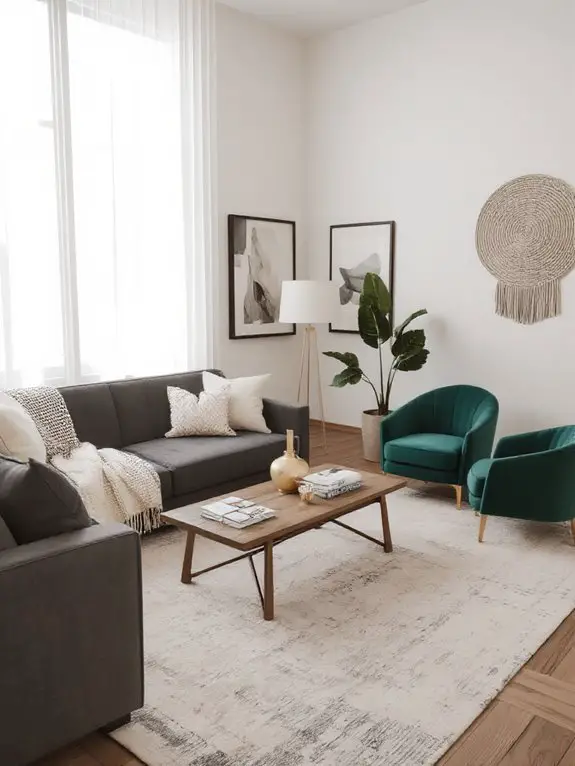
To create visual interest in a living room with a neutral palette, I focus on layering textures to add depth and dimension.
Start with a plush area rug to ground the space, then layer in a mix of materials like linen throw pillows, a chunky knit blanket, and a leather or velvet sofa.
Incorporate natural elements like wood or rattan through furniture or accessories. Sheer curtains can soften the windows, while metallic accents add subtle shine.
Add Statement Lighting
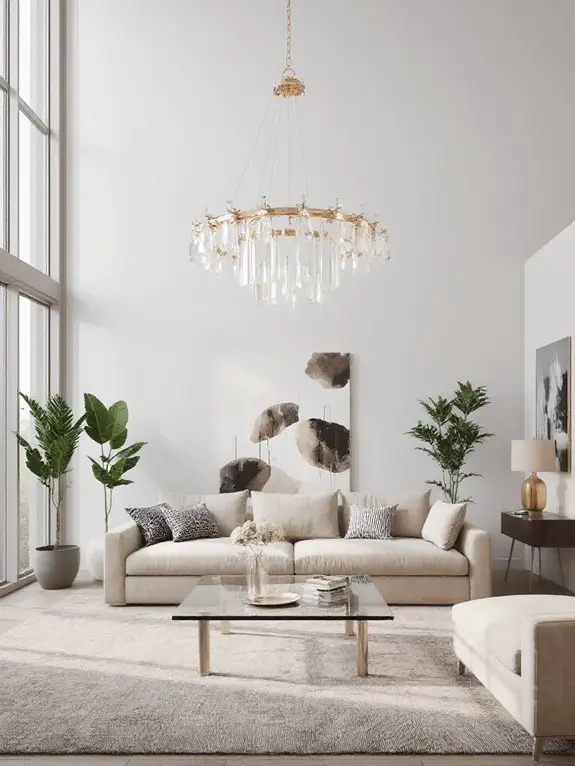
When designing a living room, I’ve found that lighting isn’t just functional—it’s a powerful design element that can transform the entire space. A statement light fixture, like a bold chandelier or sculptural pendant, instantly draws the eye and sets the tone.
I always consider the scale of the room; oversized pieces can anchor a large space, while smaller, unique options work well in cozier settings.
Layering with dimmable lights adds versatility, creating ambiance for any occasion. Don’t shy away from materials like brass, glass, or woven textures—they add personality.
Statement lighting elevates your room’s style effortlessly.
Mix and Match Furniture Styles

Mixing and matching furniture styles can seem intimidating, but it’s one of the most effective ways to create a dynamic and personalized living room. I start by choosing a unifying element—like color, texture, or material—to tie disparate pieces together.
For example, pairing a modern sofa with a vintage wood coffee table creates contrast while maintaining harmony if both share a neutral palette. I also balance proportions; a sleek, low-profile chair complements a bulky, traditional armchair.
Mixing metals or finishes, like brass and black iron, adds depth. Remember, cohesion doesn’t mean uniformity—it’s about creating a space that feels curated, not chaotic.
Create a Cozy Reading Nook

Although a cozy reading nook may seem like a luxury, it’s a practical addition that transforms any underutilized corner into a personal retreat. I start by selecting a comfortable chair or small loveseat, making sure it’s upholstered in soft, inviting fabric. Adding a side table for my books and a cup of tea keeps everything within reach.
A floor lamp or wall sconce provides focused lighting, perfect for late-night reading. I layer texture with a plush throw and a couple of accent pillows. Finally, a small rug anchors the space, making it feel intentional and cozy. It’s my favorite spot to unwind.
Use Mirrors to Enhance Space
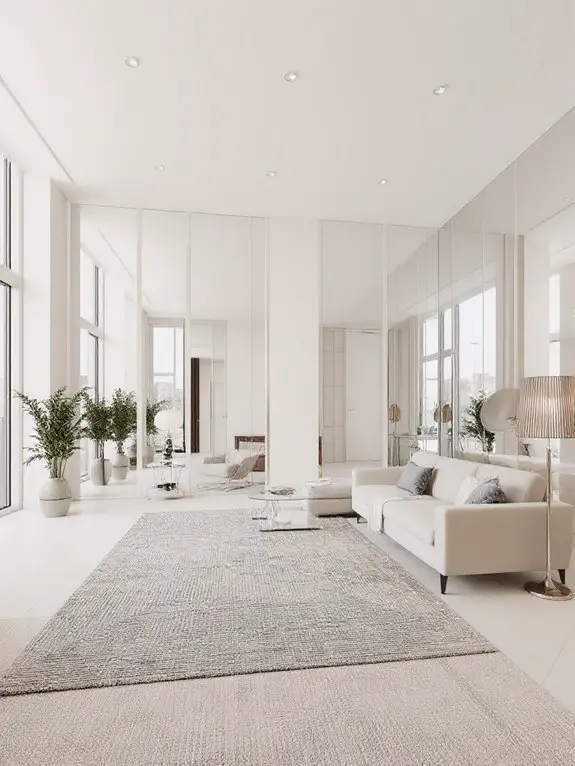
Because mirrors can dramatically alter the feel of a room, I often use them to make spaces appear larger and more open. Placing a large mirror opposite a window reflects natural light, instantly brightening the area and creating depth.
I lean toward sleek, minimalist frames for modern interiors or ornate designs to complement traditional décor. Strategically positioning mirrors near key focal points, like artwork or furniture, draws the eye and enhances the room’s flow.
In smaller living rooms, I’ve found that grouping smaller mirrors creates visual interest without overwhelming the space. Mirrors are a simple yet powerful tool to transform any room effortlessly.
Opt for Multi-Functional Furniture

When space is at a premium, multi-functional furniture can be a game-changer for maximizing utility without sacrificing style. I always look for pieces that serve dual purposes, like a sofa bed for overnight guests or an ottoman with hidden storage for blankets and books.
A coffee table that doubles as a desk or dining surface is another smart choice, especially in small apartments. Nesting tables or foldable chairs are perfect for flexible seating when needed.
Incorporate Indoor Plants
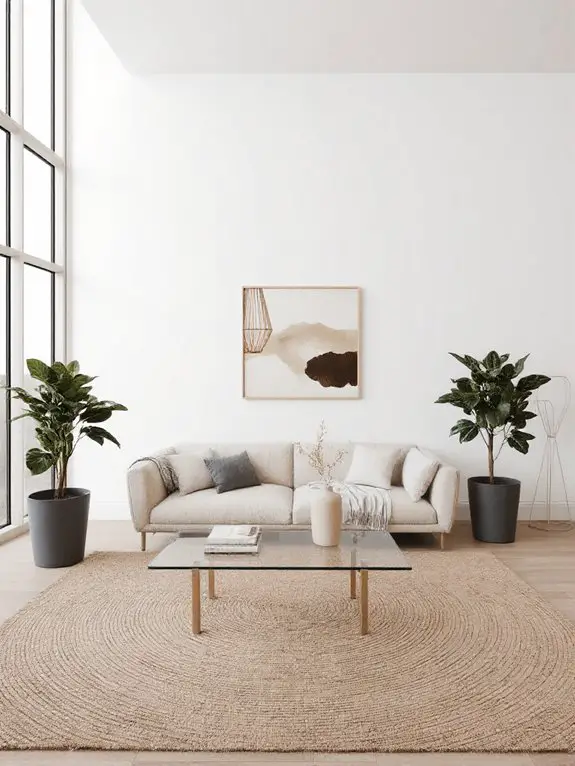
Indoor plants can transform a living room by adding life, texture, and a sense of calm to the space. I like to choose plants that thrive indoors, such as snake plants, pothos, or fiddle leaf figs, as they’re low-maintenance and adaptable.
Placement is key—I often use larger plants as focal points in corners or beside furniture, while smaller ones work well on shelves or tabletops. Grouping plants in varying heights creates visual interest.
I also consider light levels; for example, I’ll place a sun-loving plant near a window, but a shade-tolerant one in darker corners. Plants make the room feel fresh and inviting.
Experiment With Gallery Walls
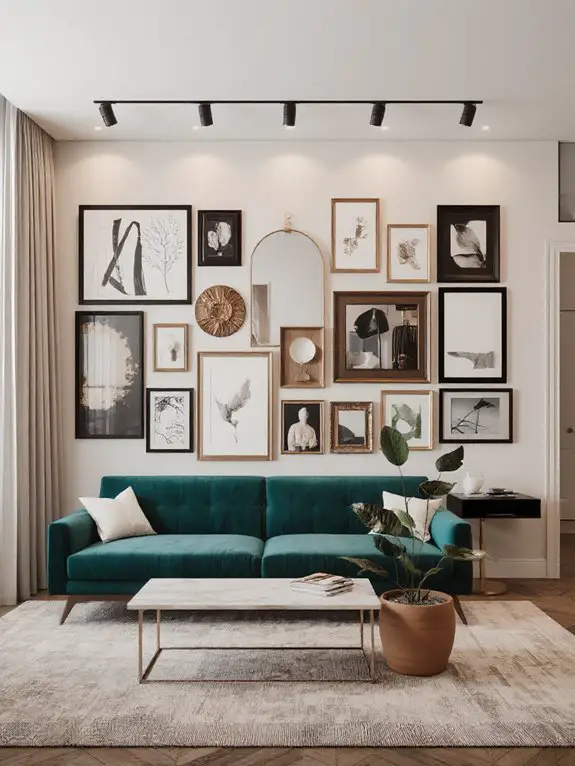
Gallery walls bring personality and creativity to a living room, allowing you to showcase art, photos, or meaningful decor in a cohesive way. I start by selecting a theme or color palette to tie everything together.
Mixing different frame styles adds visual interest, but I keep them within a similar tone for harmony. I lay out the arrangement on the floor first, playing with spacing and balance before hanging.
Odd numbers of pieces often feel more dynamic. I also incorporate varied sizes and textures to avoid monotony. A gallery wall becomes a focal point that reflects my style and tells my story effortlessly.
Play With Geometric Patterns
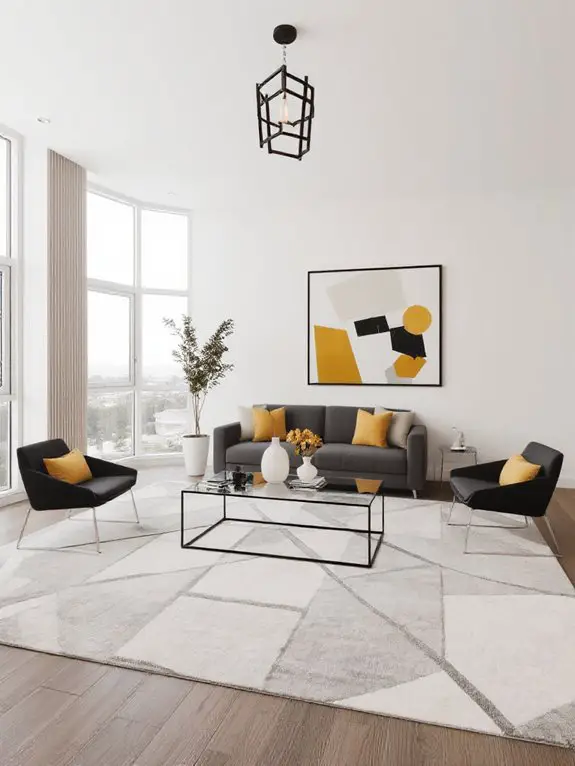
Geometric patterns can instantly elevate a living room’s aesthetic by adding structure and visual intrigue. I love incorporating them through rugs, throw pillows, or wallpaper to create a cohesive yet dynamic look. Mixing shapes like triangles, hexagons, and chevrons can balance symmetry with energy.
I often stick to a neutral palette for larger pieces, like a patterned sofa, and layer in bolder designs with smaller accents. Experimenting with scale—pairing large motifs with subtle ones—adds depth without overwhelming the space.
Geometry’s versatility makes it timeless, and I’ve found it’s a surefire way to infuse modern sophistication into any interior.
Add a Pop of Color With Accessories
After exploring geometric patterns to bring structure and modernity to a living room, I find that layering in vibrant accessories can breathe life and personality into the space. Start with bold throw pillows or a striking vase—small touches that won’t overwhelm but still make a statement.
A colorful art piece or patterned curtains can anchor the room’s palette. I prefer mixing textures, like a velvet cushion with a ceramic lamp, to add depth. Stick to two or three accent colors to keep it cohesive. These details transform a neutral base into a dynamic, inviting space without committing to permanent changes.
Use Rugs to Define Spaces
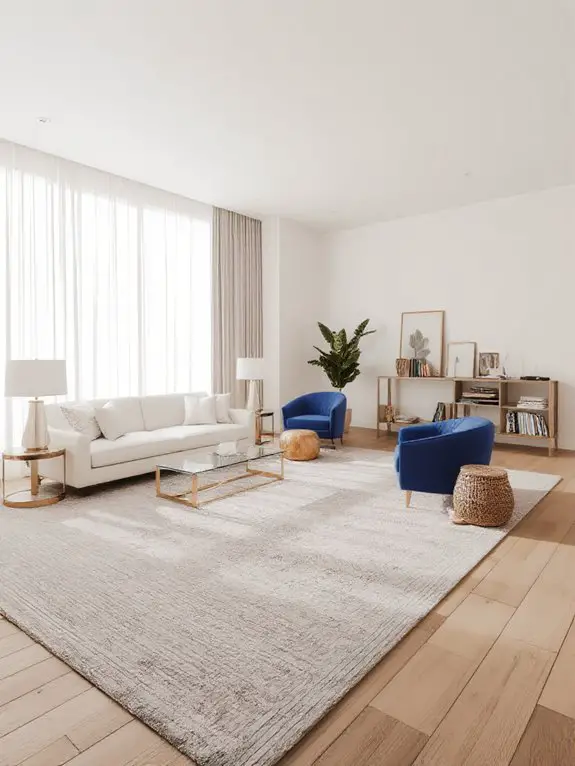
When arranging a living room, I’ve found that rugs are an essential tool for defining spaces, especially in open layouts. By placing a rug under the seating area, I create a visual anchor that separates it from other zones, like dining or entryways. I always choose a size that allows furniture legs to sit comfortably on the rug, ensuring cohesion.
Layering rugs can add depth, but I keep patterns and colors complementary to avoid overwhelming the room. For smaller spaces, I opt for lighter tones to make the area feel larger.
A well-placed rug not only defines space but also enhances comfort and style.
Introduce Metallic Accents

Metallic accents can elevate a living room’s design by adding a touch of sophistication and visual interest. I like to incorporate them subtly through pieces like lamps, frames, or decorative bowls. Gold and brass bring warmth, while silver and chrome offer a cooler, modern feel.
Mixing metals can work if there’s a unifying element, such as a shared finish or texture. I avoid overdoing it; a few well-placed accents create balance.
For instance, a metallic coffee table base or a polished side table can anchor the space without overwhelming it. These details make the room feel curated and intentional.
Install Built-In Shelving

Built-in shelving transforms a living room by combining functionality with style, offering both storage and a display space for decor. I always recommend choosing materials that complement the room’s aesthetic, like wood for warmth or painted finishes for a modern look.
Customizing the dimensions guarantees the shelving fits seamlessly into the space, whether it’s flanking a fireplace or accenting a blank wall. I layer items like books, plants, and art to create visual interest, often arranging them by height or color for balance.
Lighting, such as LED strips or sconces, adds depth and highlights key pieces, enhancing the overall design effortlessly.
Choose a Focal Point
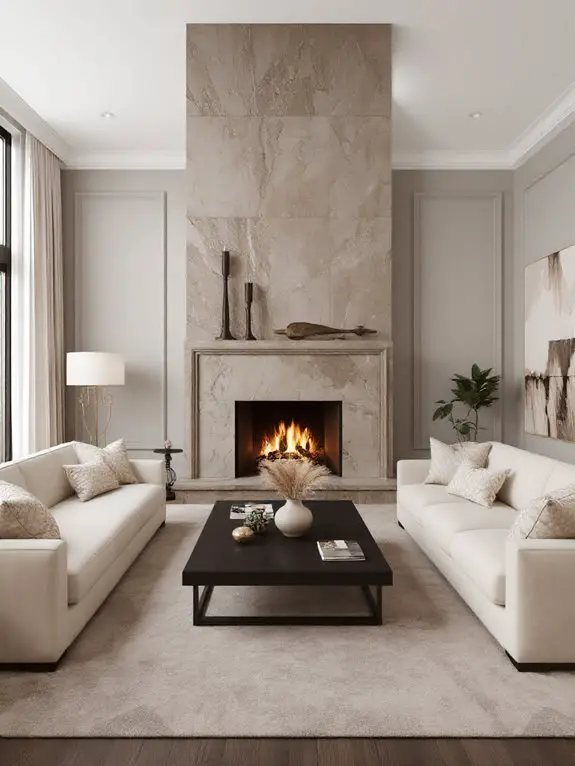
A focal point anchors the living room, drawing attention and setting the tone for the entire space. When I design a room, I start by identifying what naturally stands out—whether it’s a fireplace, a large window, or a statement piece of furniture.
If my room lacks an inherent feature, I create one with an eye-catching artwork or a bold accent wall. I make certain the focal point is visible from the primary seating area to maximize its impact.
Surrounding elements should complement, not compete with, this centerpiece. By focusing on one dominant feature, I achieve a cohesive and balanced design that feels intentional.
Blend Vintage and Modern Elements
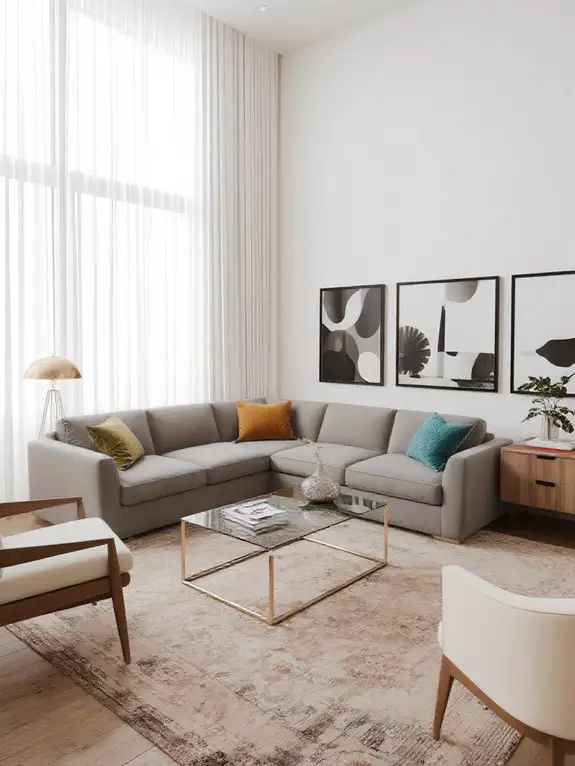
To create a harmonious blend of vintage and modern elements, I focus on balancing old and new without letting one style overpower the other.
I start by anchoring the room with a modern sofa or minimalist rug, then layer in vintage pieces like an antique coffee table or retro lamps.
Mixing textures—like a sleek metal side table with a worn leather armchair—adds depth. I keep the color palette neutral to unite the styles seamlessly.
Finally, I incorporate a few statement accessories, such as a modernist sculpture or vintage artwork, to tie everything together without overwhelming the space.
Utilize Vertical Space
When designing a living room, I often find that vertical space is an underutilized resource that can dramatically enhance both functionality and aesthetics. By incorporating tall bookshelves or floor-to-ceiling cabinets, I create ample storage without sacrificing floor space.
Hanging floating shelves or artwork higher on the walls draws the eye upward, making the room feel larger and more dynamic. I also love using vertical gardens or tall indoor plants to add life and texture.
Installing vertical lighting, like sconces or pendant lights, can highlight key areas and add warmth. These strategies maximize every inch while maintaining elegance and practicality.
Incorporate Natural Materials
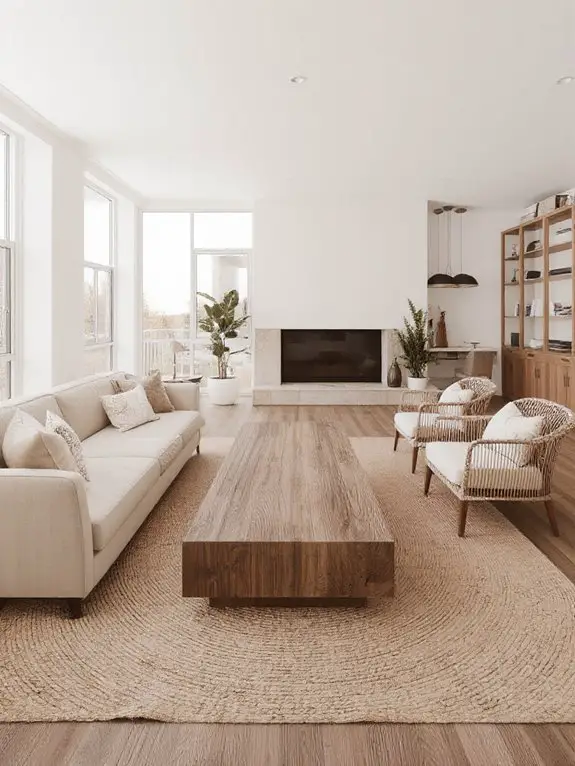
If I’m aiming to create a warm and inviting living room, incorporating natural materials is a go-to strategy that instantly elevates the space. I love using wood for furniture or flooring—it adds warmth and character.
Stone accents, like a marble coffee table or granite shelves, bring texture and sophistication. Woven elements, such as jute rugs or rattan baskets, introduce a cozy, earthy vibe.
Linen or cotton textiles soften the look while maintaining that natural feel. Even small touches, like a wooden picture frame or a clay vase, make a difference.
These materials connect the room to nature, making it feel grounded and timeless.
Create a Monochromatic Scheme

Though it might seem simple, crafting a monochromatic scheme requires thoughtful planning to guarantee depth and interest in your living room. I start by choosing a base color—like soft gray or warm beige—then layer shades and tones to add dimension.
Textures are key; I mix velvet pillows with a linen sofa or a sleek metal lamp to break up uniformity. A single accent piece in a contrasting material, like a wooden coffee table, keeps the space from feeling flat.
Lighting also plays a role—I use warm and cool tones to highlight different layers, ensuring the room feels cohesive yet dynamic.
Add Curtains for Elegance
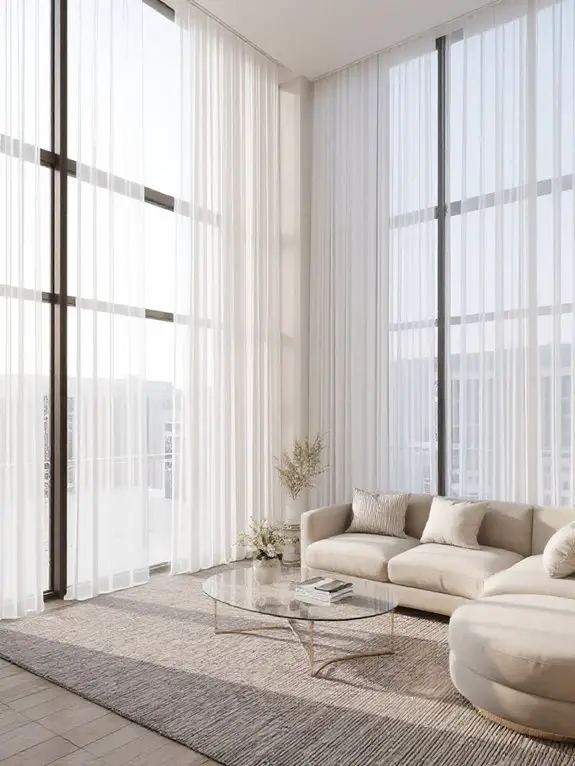
Curtains are a simple yet transformative addition to any living room, instantly elevating its elegance while offering both functionality and style. I love how they frame windows, softening harsh lines and adding depth to the space.
Opt for floor-length panels in luxurious fabrics like velvet or linen to create a polished look. Neutral tones keep things timeless, but a bold pattern or rich color can make a statement.
Don’t forget hardware—brushed brass or matte black rods add sophistication. Sheer layers diffuse light beautifully, while blackout liners provide privacy.
It’s an easy upgrade that makes the room feel intentional and refined.
Use Open Shelving for Display

Open shelving can transform your living room by combining functionality with aesthetic appeal, making it an excellent choice for showcasing your personality. I love how it lets me display curated collections, books, or plants while keeping essentials within reach.
To avoid clutter, I stick to a cohesive color palette or material theme—like wood or metal—for a polished look. Staggering items in height and texture adds visual interest.
I also leave some breathing room between objects to prevent overcrowding. For a balanced feel, I mix decorative pieces with practical items like baskets or trays. It’s an effortless way to elevate your space.
Experiment With Bold Ceiling Designs
Bold ceiling designs can completely redefine the atmosphere of your living room, adding depth and character to an often-overlooked space. I’ve found that painting the ceiling a dramatic color, like navy or charcoal, instantly draws attention upward and adds a sense of sophistication.
If you’re feeling adventurous, try incorporating patterned wallpaper or geometric designs—they can create a striking focal point.
For texture, consider exposed beams or a coffered ceiling, which add warmth and dimension.
Lighting also plays a role; recessed fixtures or a statement chandelier enhance the design. It’s a simple way to elevate your space and make it unforgettable.
Create a Cozy Fireplace Area
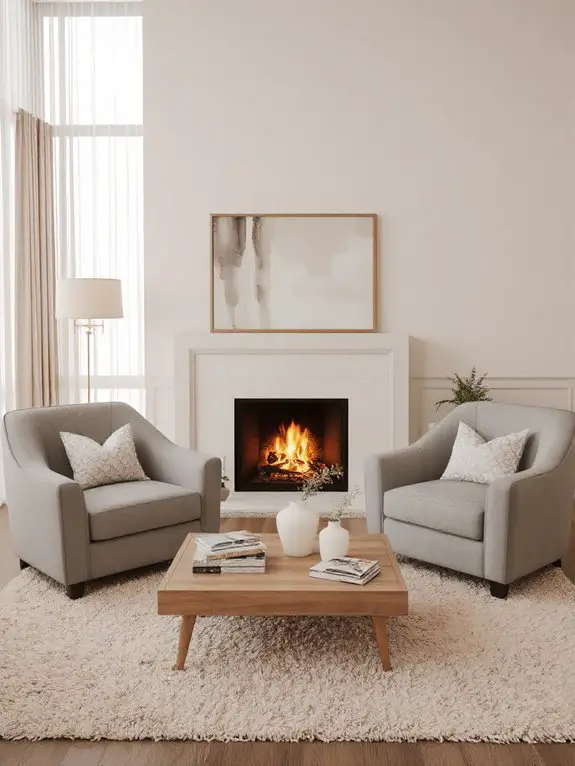
While a bold ceiling design can elevate your living room’s aesthetic, turning your attention to the fireplace area can create a warm, inviting focal point.
I start by arranging comfortable seating, like a plush armchair or a sofa, close to the hearth to encourage conversation. Adding a soft area rug anchors the space and enhances coziness.
I layer in texture with throw blankets and cushions in neutral or earthy tones. To personalize the area, I display artwork or a mirror above the mantel and incorporate decor like candles or stacked logs.
Finally, I guarantee the lighting is soft, using table lamps or string lights for ambiance.
Frequently Asked Questions
How to Clean and Maintain Minimalist Furniture?
I keep my minimalist furniture clean by wiping it daily with a microfiber cloth. For stains, I use a mild soap and water solution. I avoid harsh chemicals and dust weekly to maintain its sleek look.
What Are Budget-Friendly Alternatives for Statement Lighting?
I’m looking for budget-friendly alternatives for statement lighting—DIY paper lanterns or thrifted chandeliers work wonders. I’d consider string lights hung creatively or spray-painting old fixtures. It’s about making bold choices without breaking the bank.
How Often Should Indoor Plants Be Watered?
I’ve learned indoor plants usually need watering every one to two weeks, but it depends on the type and environment. I always check the soil—it should feel dry an inch down before I water again.
Can Bold Accent Walls Work in Small Rooms?
I’ve found bold accent walls can transform small rooms, add depth, and create focus. I choose dark hues for drama, light shades for openness, and patterns for dimension. It’s all about balance and intention in my design.
What Are the Best Rugs for Pet Owners?
I’d look for rugs that’re durable and easy to clean, like low-pile or synthetic options. Machine-washable rugs save time, and darker patterns help hide stains. I’d avoid delicate materials since pets can be messy.

